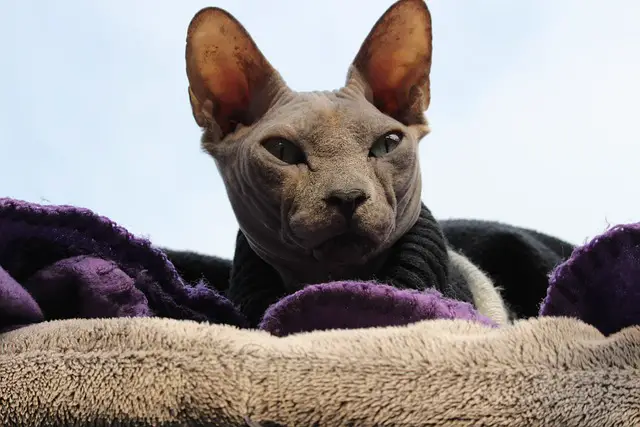Sphynx cats are a unique breed that has become increasingly popular due to their hairless appearance. However, as with any pet, there are specific considerations that potential owners must consider before bringing a Sphynx cat into their home.
One of the most common questions that arise is whether or not Sphynx cats can be declawed.
Declawing is controversial in animal welfare, with many organizations and veterinarians vehemently opposed to the practice.
While it is legal in some countries, many others have banned the procedure due to concerns about the physical and emotional harm it can cause to cats.
As such, Sphynx cat owners must understand the potential risks and benefits of declawing before deciding.
What is declawing?
Declawing is a surgical procedure involving amputating a cat’s toes at the first joint. It is also referred to as onychectomy. The procedure is performed to remove a cat’s claws and prevent it from scratching furniture, people, or other animals.
Declawing is often considered a controversial and inhumane practice, as it involves the removal of a cat’s natural defense mechanism.
The procedure can cause pain, discomfort, and long-term physical and psychological problems for the cat. In some countries, such as the United Kingdom, declawing is illegal, while in others, such as the United States, it is still legal but highly debated.
It is important to note that declawing is not the same as trimming a cat’s claws. Trimming a cat’s claws involves cutting the sharp tip of the claw, while declawing involves removing the entire claw and part of the bone.
Trimming a cat’s claws is a routine grooming practice that can be done at home or by a veterinarian, and it is a painless and safe procedure for the cat.
Why Declawing is Not Recommended
Physical and Behavioral Effects of Declawing
Declawing is a surgical procedure involving amputating each toe’s last bone. This procedure is not just the removal of a cat’s claws but the removal of a cat’s entire toe bone. This can cause several physical and behavioral effects on the cat, including:
- Chronic pain
- Difficulty walking and balancing
- Limited mobility
- Infections and bleeding
- Increased aggression and biting
- Litter box avoidance
These effects can last the rest of the cat’s life and severely impact its overall quality of life.
Alternatives to Declawing
Several alternatives to declawing can help protect furniture and other household items without causing harm to the cat. These alternatives include:
- Providing scratching posts and pads
- Trimming the cat’s nails regularly
- Using soft nail caps
- Training the cat to scratch appropriate surfaces
By providing these alternatives and training the cat, owners can protect their furniture and keep their cats healthy and happy.
Can Sphynx Cats be Declawed?
Sphynx cats are known for their unique appearance and personality. They are a hairless breed that is friendly, affectionate, and curious. They are also known for their sharp claws, which can cause damage to furniture and other household items. This has led many owners to consider declawing their Sphynx cats.
Declawing Sphynx Cats: Pros and Cons
There are pros and cons to declawing a Sphynx cat. On the one hand, it can prevent damage to furniture and other household items. It can also reduce the risk of injury to other pets and family members. On the other hand, it can cause long-term physical and emotional problems for the cat.
Some of the pros of declawing a Sphynx cat include:
- Preventing damage to furniture and other household items
- Reducing the risk of injury to other pets and family members
Some of the cons of declawing a Sphynx cat include:
- Causing chronic pain and discomfort
- Increasing the risk of arthritis and other joint problems
- Leading to behavioral issues, such as aggression and litter box avoidance
Overall, declawing a Sphynx cat is a controversial and potentially harmful procedure. It is important for owners to consider the long-term physical and emotional effects on their cat before making a decision.
Conclusion
Declawing is a controversial issue in the world of cat ownership. While some people believe that declawing is necessary to protect their furniture and belongings, others see it as a cruel and unnecessary procedure.
When it comes to sphynx cats, the decision to declaw should be made carefully and with consideration for the cat’s well-being. While sphynx cats are often described as being more tolerant of declawing than other breeds, it is still a major surgery that can cause pain and discomfort.
Before making a decision to declaw a sphynx cat, it is important to consider alternatives such as providing scratching posts and training the cat to use them. If declawing is deemed necessary, it should only be done by a qualified veterinarian using the most humane methods possible.
In the end, the decision to declaw a sphynx cat is a personal one that should be made with careful consideration for the cat’s health and well-being. While declawing may seem like an easy solution to a scratching problem, it is important to remember that it is a major surgery that can have long-term effects on the cat’s physical and emotional health.
[su_box title=”Affiliate Disclosure”]This website is supported by its readers. Please assume that all links are affiliate links. If you make a purchase from one of the links we will make a commission from Amazon. Thank you.[/su_box]




